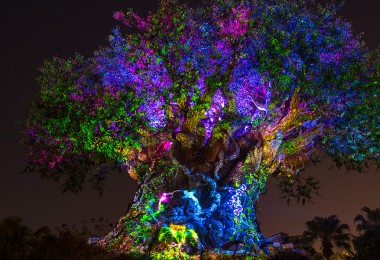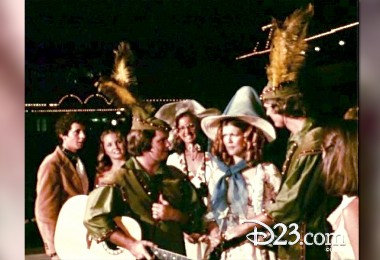By Jim Fanning
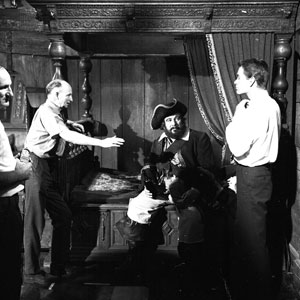
“The most fearsome pirate ever,” Ian McShane, who portrays the infamous Blackbeard in Pirates of the Caribbean: On Stranger Tides, rightly observes. “There’s a legion of stories about him, and whether they’re true or not, he’s now part of pirate mythology.” Blackbeard’s Ghost (1968) followed in the side-splitting tradition of Walt Disney’s wacky live-action comedies, such as The Shaggy Dog (1959) and The Absent-Minded Professor (1961). This comedy-fantasy, big-screen success tells the salty tale of the spectral return of Blackbeard’s spirit to the New England coastal town of Godolphin where the supernatural scallywag attempts to perform just one good deed so that his spellbound spirit can finally rest. To achieve this seemingly impossible task, Captain Blackbeard sets out to help the landlubber of a track coach (Dean Jones) — the only one who can see or hear the ghostly pirate — and his less-than-athletically talented Godolphin College team win a big meet. But before we dive into how this unlikely tale became a hit, we’d better bring you up to speed with the history of Blackbeard the man. He was a real-life British-born buccaneer who plundered along the West Indies and the eastern coast of what were then the American colonies in the early 18th century. He was named Edward Teach by birth, but eventually earned his nefarious nickname due to his fearsome facial hair. Blackbeard relied on his ferocious appearance to intimidate his quarry and it was rumored that he tied lit fuses to his infamous beard to create a supernatural mist around him in order to frighten his foes into giving up their treasure.

Acclaimed illustrator Ben Stahl was fascinated with this larger-than-life character from the past and wrote a book about him. “Edward Teach, alias Blackbeard, was the craftiest rogue who ever buckled a swash and yet he had a streak of fun and humor in him that made many of his victims almost forgive his outrages,” Stahl, who is known for his evocative, romantic artwork seen in many magazines including The Saturday Evening Post and for grand promotional art for Hollywood films like Ben-Hur (1959), says. Stahl wrote the 1965 novel Blackbeard’s Ghost by first painting the plot and then writing it out. While he was in Burbank completing an assignment for Warner Bros. Ben had lunch with Walt Disney and showed him the unfinished manuscript of Blackbeard’s Ghost, with its imaginative tale of two boys who accidentally conjure up the specter of the notorious Edward Teach. Walt encouraged Stahl to complete the book, adding, “When it’s finished, I’d like to have a look at it.” Once it was completed, Stahl gave the unpublished book to Walt and awaited the great showman’s response. Three days later — the same day that publisher Houghton Mifflin accepted the book for publication — Walt telegraphed Ben, “I think it turned out swell. I would like to have the film rights.” It was clear the pirate’s tale with a comedic twist captured Walt’s imagination for, as director Robert Stevenson, an Academy Award®-nominee for Mary Poppins (1964), revealed, Walt was heavily involved in the creation of the film’s storyline. “He seemed to have an enormous amount of energy when he worked on [the script],” Stevenson reported. Though the completed film was not released until over a year after his death, Blackbeard’s Ghost was planned and cast with Walt’s involvement and approval. In fact, filming was well under way before Walt’s untimely passing in December 1966. Starting with The Absent-Minded Professor, Walt had hit upon the crowd-pleasing concept of combining cartoony impossibilities with sporting events, so he replaced the book’s two boys with an adult coach so that Blackbeard — more interested in mischief than mayhem — could invisibly help his track team to uproarious effect. The wacky, witty screenplay was crafted by Bill Walsh and Don DaGradi, the Oscar®-nominated screenwriters of Mary Poppins. A seasoned animation artist, DaGradi was particularly adept at creating gravity-defying sight gags that could only come to the screen via the magic of Disney special effects. The most special effect of them all, however, was Peter Ustinov’s portrayal of Captain Blackbeard. “Walt liked Ustinov,” Bill Walsh noted, and no wonder. At the time Walt cast him as the roguish Blackbeard, the multi-talented British star had authored 16 plays, seven movie scripts and six books, produced five top-selling records, starred in 14 plays, directed six films and appeared in over 100 others, written and starred in his own radio show and also served as a newscaster, magazine writer and illustrator. A few of Peter’s many awards included two Oscars, for his supporting roles in Spartacus (1960) and Topkapi (1964) and an Emmy® award for Best Performance by an Actor for portraying Samuel Johnson on television’s Omnibus. (He would go on to win two additional Emmy awards.) “Ustinov,” Walsh added, “is probably one of the most brilliant men in out industry. He is considered one of the world’s greatest conversationalists and can tell stories for hours on end. He mimics and impersonates everyone there is. In fact, Peter was so entertaining that people from all over the lot would find an excuse to drop in for a minute that would somehow stretch into half an hour. He was marvelous during takes as well. Since he writes beautifully, he was always changing the dialogue. This would often result in funnier lines and business, but it more importantly kept the other actors fresh. Whereas third and fourth takes of the same scene can be deadly, Peter made each one different.”

The rotund Renaissance man was paired with co-star Dean Jones. This popular Disney player filled the role of Blackbeard’s straight man with his own masterfully played comedic reactions. “Dean’s job was especially difficult in this film,” observed Bill Walsh, “because he had to play straight man to Peter Ustinov. Peter is a sort of quick-witted and whimsical genius that never played a scene the same way twice. This kept everyone in the cast on their toes, particularly poor Dean, who as much as everyone else enjoyed Peter’s adlibbing. But the nuttier the situation got, the more sincere Dean became. It isn’t every actor who can do this. Most of them go wrong in fantasy-comedies because they get cute with the material. A ghost can cut-up but not the serious lead. Dean was able to play it straight, and that, as much as Peter Ustinov’s magnificent performance, is responsible for the solid piece of entertainment that we have in Blackbeard.” The bi-play between the modern day guy and the 18th century swashbuckler may be another reason why the track coach character was added to the story. Jones and Ustinov’s witty banter is a favorite element of the film among its fans. Cast as a child psychology professor at Godolphin College, Suzanne Pleshette had already been successfully teamed with Dean Jones in The Ugly Dachshund (1966). A gifted comedienne whose comic talents were fully celebrated the classic TV series The Bob Newhart Show, Suzanne enjoyed working at the Disney Studios, and Walt was tickled by the spark the sassy actress brought to his comedies. Elsa Lanchester, a Disney favorite from Mary Poppins and That Darn Cat (1965), plays Emily Stowecroft, the eccentric innkeeper who welcomes the new track coach to Blackbeard’s Inn. Known for roles in classic films since the 1930s — most infamously as the iconic female monster in Bride of Frankenstein (1935) — this veteran character actor brought her piquant brand of comedic performance to the proceedings as the leader of an unlikely woman’s group called the Daughters of the Buccaneers. Cast as one of its elderly but energetic members, former silent-screen star Betty Bronson had been personally selected by author J.M Barrie for the first screen version of Peter Pan (1924; Walt Disney reportedly purchased this film in 1938 when he first began plans to produce his animated version). Kathryn Minner was famous as the “Little Old Lady” in a series of Dodge TV commercials for which she won many awards and led to guest appearances on numerous TV shows, including The Tonight Show Starring Johnny Carson. Celebrating her 75th anniversary in show business, character actress Elsie Baker had a talent for screaming for many famous actresses who couldn’t get the proper terrified quality into their own shrieking, including in several Alfred Hitchcock productions. Elsie doesn’t scream in Blackbeard though she felt like it, “especially when that old pirate ghost just appears outta nowhere.”
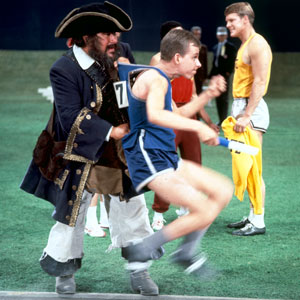
Thanks to Blackbeard‘s ghostly antics, the film’s visual reaches high tide during the track meet when the piratical poltergeist lends an invisible hand to Godolphin’s puny track-and-fielders. Even so, there was more to please the eye than Blackbeard’s spectral shennigans during the athletic event. “To make the sequence come across as an authentic college meet, we needed some cheerleaders to complete the picture,” said Bill Walsh. “We were watching a UCLA football game and it seemed that the cameraman was enamored with the UCLA cheerleaders, and we saw more of them than we did the game. We practically had to call the paper to get the results of the game. UCLA won. But the point is that we did see a lot of the girls in action. And they were very attractive. When the time came to select cheerleaders for the track meet, there was no question in our minds. They did an excellent job. Just like on TV.” The names of the cheerleaders are Linda Lockwood, Elaine Larkins, Holly Borowiak, Donna Laughlin, Lynn Switzer and Renee Stuber. “Peter, who is probably one of the most brilliant figures in our industry today, even learned their routine for one of the scenes,” Walsh reported. One of film’s most memorable visual treasures is the larger-than-life painting of the legendary painting that hangs in a place of honor in Blackbeard’s Inn. Illustrator David Jonas, who was a Disney Studios artist in the late 1960s to the early 1970s, painted this magnificent portrait. “It’s not easy doing a portrait of someone that you can’t even get a good recent photo of,” remarked David. “I did a lot of research on what the actual Blackbeard looked like and portraits of that period so that I could give the figure an authentic pose and background. As it turned out, I had the pirate standing on the beach with a sinking ship on the horizon, suggesting his prowess over the seas. I roughed in the figure and with wardrobe designer Bill Thomas worked out the costume he would be wearing. I took the six by four foot canvas home with me and tinkered with it for about three weeks, and using some old pictures of Ustinov in magazines I’d found, I more or less sketched in the face and added a goodly roguish beard. By the time Peter arrived at the studio for production, the painting for all but subtle modeling and little details was finished.”
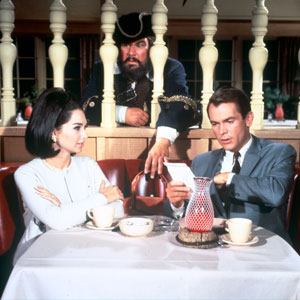
Blackbeard’s Ghost materialized at a splashy premiere on February 8, 1968, at the Pantages Theater on Hollywood Boulevard near Vine. Befitting the film’s sports theme, this swank affair benefited the Southern California Chapter of the United States Olympians, comprised of former Olympic athletes actively promoting the current teams. More than 100 Olympic greats attended, including Congressman Bob Mathias and Jesse Owens. The premiere was hosted by Disneyland Ambassador Sally Sherbin and co-“ghosted” by Ivan Jay (standing in for Ustinov who was unable to attend) as Blackbeard. The 60-piece UCLA Varsity Band, directed by Kelly James, played in front of the glitzy movie palace, accompanied by the UCLA Songbirds and the cheerleaders seen in the film. Renowned sportscaster and captain of the 1936 Olympics gold medal-winning basketball player, Sam Balter was the emcee. The film was introduced by Chairman of the Southern California Olympic Fund Bill Schroeder, who extended his personal gratitude to Disney for inviting the Olympians to sponsor the event. “The house is a complete sell-out thanks to the Olympians themselves, who’ve worked very hard in cooperation with Disney to make this evening the success that it is,” Schroeder said. In addition to Dean Jones, Suzanne Pleshette and Elsa Lanchester (and those behind-the-scenes superstars Bill Walsh, Don DaGradi and Robert Stevenson), James Garner, Edward G. Robinson, Glenn Ford, Troy Donahue and Carol Lynley attended. Once the film rolled, Dean and Suzanne were whisked away to nearby 1313 N. Vine St. for the live broadcast of The Joey Bishop Show for a lively chat about the premiere. (The Joey Bishop Show had promoted both the film and the benefit the night before with guests Bob Mathias and Jesse Owens.) A boatload of fun, Walt Disney’s Blackbeard’s Ghost glitters with sight-gag gems and jewel-like performances, especially from Peter Ustinov as the ghostly pirate. In Ustinov, Disney gained a valuable member of its repertory company, for this versatile performer would return for several other projects: the Walsh -written and -produced/Stevenson-directed One of Our Dinosaurs is Missing (1975); Treasure of Matecumbe (1976); and most importantly Robin Hood (1973), for which Peter gave one of the richest vocal performances in all of Disney animation as the sniveling pretender-to-the-throne Prince John. In 1997, Disneyland’s Pirates of the Caribbean attraction boasted a new scene with two brigands attempting to haul treasure from the burning village that included a salute to Blackbeard’s Ghost: the film’s painted portrait of the notorious pirate among the booty. Today as much as ever, fans of Disney pirates treasure Blackbeard’s Ghost, starring “The Jolliest Roger of them all!”



